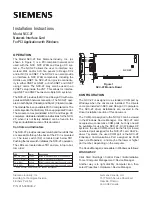
PC IEEE Reference
Technical Details.
ATN ATteNtion.
_______________
The IEEE ATN line has TWO connections into the PIA
and hence the computer. This permits many useful extra
functions to be incorporated into the IEEE interface. The normal
ATN signals are sent from the computer through PORT B bit 6
and are controlled by the device driver. There is also an ATN
input only line connected to CA1 of the PIA. If you want the
computer to act as a peripheral, ie a pseudo disk drive or printer
say then DC should be set HIGH. To turn ATN round from
send to receive use the SLAVE command.
An IRQ to interrupt the processor can be generated by
ATN transitions generated by an external controller (another
computer, say) by appropriate setting of CRA. Otherwise ATN’s
can be detected by polling the IRQA1 flag in bit 7 of CRA of
the PIA. The IRQ or polling routine must recognise the PC
IEEE’s device number, this to prevent interference with other
devices on the bus. The device number is set by using the
MLA=, MSA=, MTA= and MYA= commands. Once a valid
device number has been detected the user handshakes the data in
or out of his computer using the device driver. Best response is
with the IRQ jumper block and corresponding interrupt vector
stolen to point to an input handshake routine. Alternatively the
WAIT MYA or WAIT MLA etc commands followed by a
SEND or READ command can be used to build IEEE device
functions into the PC IEEE.
Page 32
Chapter 3





































